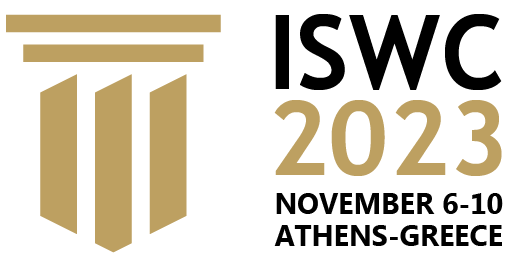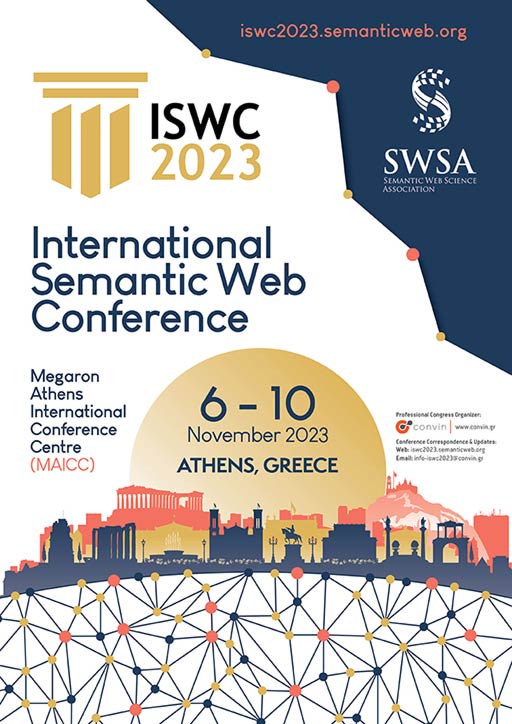The International Semantic Web Conference is the premier venue for presenting fundamental research, innovative technology, and applications concerning semantics, data, and the Web.
The research track of ISWC 2023 solicits novel and significant research contributions addressing theoretical, analytical and empirical aspects of the Semantic Web. We welcome work describing original and replicable research showing evidence of significant contribution to the Semantic Web.
All papers will be assessed by the track’s program committee. Each paper will be reviewed by at least three committee members, with a meta-review provided by a senior member. The review criteria used are outlined below.
As the research track is one of several featured at ISWC 2023, authors are asked to consult the calls of the other tracks to choose the track that best suits their contribution. The submission of the same work to multiple tracks is not allowed and may result in a rejection of the work across all tracks without a review.
Important information for authors:
- Submissions are double-blind
- Papers are limited to 15 pages excluding references
- All submissions must include a mandatory Supplemental Material Statement
- Unless otherwise justified in the Supplemental Material Statement, we expect supplemental material to be provided anonymously with the submitted paper
- Objections & Responses shall be used only for exceptional cases involving clear factual errors or explicit questions in reviews
Important Dates – All deadlines are 23:59 AoE (anywhere on Earth)
| Actions | Due date |
|---|---|
| Abstract submission due | May 2nd, 2023 |
| Full paper submission due | May 9th, 2023 |
| Objection and Response | June 13th – 16th, 2023 |
| Notifications | July 12th, 2023 |
| Camera ready papers due | July 31st, 2023 |
Topics of Interest
We encourage papers that directly contribute to the advancement of the Semantic Web area. The relationship to the core area of the conference needs to be clearly described in the submitted work. Topics in this area include, but are not limited to:
- Ontologies and Knowledge Graphs, including:
- Ontology engineering and ontology patterns
- Ontology modularity, mapping, merging, and alignment
- Knowledge graph construction, maintenance, and reasoning
- Representation and Management of graphs (e.g. RDF and knowledge graphs), including:
- Knowledge Representation and Reasoning
- Search, query, integration and analysis
- Robust and scalable management of semantics and data
- Information visualization and exploratory analysis methods
- Databases and ontology based data access, integration and exchange on the Web
- Information extraction, natural language processing, Information retrieval and semantic analysis
- Integration of the Semantic Web with:
- Machine learning, data mining, and neural symbolic reasoning
- User interfaces, usability and accessibility
- Autonomous systems, including multi-agent systems and robotics
- Data integration, quality assurance, and data provenance
- Social issues including trust, privacy, security and policy
- Web services, Process Management, Social Web, and Internet of Things
- Dynamic and streaming data, including complex event processing and stream reasoning
- Software Engineering, Algorithms, and decentralized architectures
- Specialized domains (geographical, biomedical, e-Science, multimedia, performing arts, public administration, cultural heritage, law, etc.)
- Artificial Intelligence and hybrid approaches
We welcome research that does not explicitly deal with a Semantic Web standard or resource, but could be directly applied in such a setting. For example, studies that operate over triple-based (non-RDF) graphs could be trivially applied for RDF graphs and are thus also considered relevant. In such cases, we encourage authors to explicitly highlight how their work could be applied in a Semantic Web setting.
Review Criteria
Papers in this track will be reviewed according to the following criteria:
- Originality & novelty
- Relevance and impact of the research contributions
- Technical soundness
- Rigor and reproducibility of the work (including evaluation)
- Clarity and quality of presentation
- Grounding in the literature
Any submissions that are clearly out of scope, or have significant omissions with respect to these criteria may be subject to desk-rejection prior to a full review. Guidelines for reviewers are available here.
Objection & Response
In the exceptional case of factual errors in reviews, or direct questions raised by the reviewers, the authors will have the opportunity to respond.
In order to reduce workload on authors and reviewers, while also providing an opportunity for author feedback in exceptional cases, the “Objection & Response” phase can be used, in two cases:
- In order to highlight clear factual errors in reviews regarding the content of the submission.
- In order to respond to explicit questions from reviewers.
Any information or comment not addressing these two cases may be ignored.
Supplemental Material Statement and Reproducibility
Reproducibility is a key goal of scientific research. We require authors of all papers to include a statement at the end of their submission that facilitates the independent reproducibility or verification of the results presented (where relevant), pointing to where supplemental material can be found. These resources may include datasets, queries, code, proofs of results, configuration details, hyperparameters, etc., depending on the contributions of the paper. The statement should cover all of the resources necessary to reproduce or verify the results presented in the paper. In case that certain resources cannot be made available (e.g., due to privacy, ethical or financial concerns), the statement should include a justification of why this is the case. In case that the paper is fully self-contained and does not have additional resources associated (e.g., a theoretical paper with full proofs contained in the body of the paper), a short statement can be provided arguing that the paper is self-contained. Please see the Supplemental Material Statement Guide for more details.
Reviewers will be asked to evaluate the statement. In particular, they will be asked to ensure that the statement convinces them that the results of the paper are reproducible, to ensure that the resources are indeed available and support reproducibility (both now and for the foreseeable future), and, in cases where resources are not provided, to verify that there is a reasonable justification. Unless otherwise justified, it is expected that access to resources is provided from the submitted paper since these resources may often play an important role in the review process. All resources must be provided anonymously; please see the “Supplemental Material” section for recommended options.
Submission Details
Pre-submission of abstracts is a strict requirement. All papers and abstracts have to be submitted electronically via EasyChair. Submitted papers will be checked to ensure that they satisfy the submission criteria and are in scope with the aims of the conference, and if such violations are identified, then the submission may be subject to desk-rejection without review.
- Papers must provide a clear statement of their claims, argue how the results of the paper substantiate their claims, clarify any technical assumptions and/or known limitations, and provide a Supplemental Material Statement.
- All research submissions must be in English, and no longer than 15 pages (excluding references).
- Submissions must be either in PDF or HTML, formatted in the style of the Springer Publications format for Lecture Notes in Computer Science (LNCS). For details on the LNCS style, see Springer’s Author Instructions. For HTML submission guidance, please see the HTML submission guide.
- Each submission must be original. Authors need to authorize the organizer to perform a plagiarism check of the paper.
- Papers that exceed the page limit, violate the style or show any kind of plagiarism will be rejected without review.
- ISWC 2023 papers submitted to the research track will be subject to double blind peer review and must conform to the instructions (detailed below) for double-blind review.
- We encourage embedding metadata in the PDF/HTML to provide machine readable links from the paper to resources.
- Authors of accepted papers will be required to provide semantic annotations for the submission, which will be made available online. Details will be provided at the time of acceptance.
- Accepted papers will be distributed to conference attendees and also published by Springer in the conference proceedings, as part of the Lecture Notes in Computer Science series. At least one author of each accepted paper must register for the conference and present the paper. As in previous years, students will be able to apply for funding to support their travel to attend/register to the conference.
Instructions for Double Blind Reviewing
Reviewing for ISWC 2023 is double-blind, i.e., the identities of the authors and reviewers are hidden. Both authors and reviewers are expected to make every effort to honor this process. Authors should do their best to ensure that the submission can be evaluated without it being obvious who wrote the paper, and reviewers should not undertake any investigation with the specific goal of revealing the authors’ identity.
To help with the double-blind reviewing process please ensure the following when submitting to ISWC 2023:
- The first page, on which the paper body begins, should include the title and abstract but not names or affiliations of the authors.
- Remove any identifying information, including author names, from file names and ensure document properties are also anonymised.
- The references should include all published literature relevant to the paper. When referring to one’s own work, use the third person, rather than the first person. For example, say “Previously, Foo [4] showed that…,” rather than “In our previous work [4] we showed that…”
- Try to avoid including any information that would identify the authors or their affiliations. Such information may be added to the final camera-ready version for publication.
- Remove references to funding sources and/or acknowledgments. Such information may be added to the final camera-ready version for publication.
Supplemental Material
The length of the main submission is strictly limited as indicated in the call for papers. However, authors may choose to also submit supplemental material, which may include proofs of theorems that are stated in the main paper, video demonstrations, data concerning experimental evaluations, source code, and so on. Note that submissions may reference the supplemental material for further details, but should be self-contained. Reviewers are instructed to make their evaluations based on the main submission, and are not obligated to consult the supplemental material. Therefore, make sure that your submission stands on its own without them.
Please take care not to violate the blind review requirements in the supplemental material. You may make supplemental material available per one of the following options:
- OPTION 1. As a second zipped folder uploaded via the Easychair system; note that the total size of the submission (paper+supplemental materials) must not exceed 100MB.
- OPTION 2. As an anonymized link to supplemental material included in the paper. This option may be used, in particular, in case the total size of the submission (paper+supplemental materials) exceeds 100MB. We recommend the use of Github, Zenodo, Figshare or Dryad. Anonymous dataset submissions can be managed through Zenodo and Figshare without additional accounts; see, for example, this guide by Daniel Graziotin.
Supplemental material submitted at the time of submission for review will not be automatically published or posted if the paper is accepted for publication. Hence we expect authors of accepted papers choosing OPTION 1 to publish this material in one of the aforementioned repositories (or arXiv in the case of an extended version of the paper with proofs) and provide references to the supplemental material in the final camera-ready version of the paper.
In the case of both options, we strongly encourage making supplemental material available under open licenses, and providing sufficient documentation to enable reproducibility.
Prior Publication and Multiple Submissions
ISWC 2023 will not accept research papers that, at the time of submission, are under review for or have already been published in, or accepted for publication, in a journal or another conference. Prior submissions to workshops are fine as long as the authors still hold sufficient rights to publish overlapping content in the Springer proceedings. The conference organizers may share information on submissions with other venues to ensure that this rule is not violated.
Research Metadata and Comparisons
To facilitate reproducibility and give peer-reviewers a characterization of a submission by juxtaposing it with related approaches, we encourage authors to accompany their submission with an ORKG comparison in the Open Research Knowledge Graph (ORKG) (note that this is not mandatory). More information on the background and how to create an ORKG comparison can be found here (including a how-to video). This can be done during the submission process – in which case a link to the comparison can be added to the submission for reviewers, in an anonymity-preserving way. This workflow describes the steps involved in the creation of such a comparison.
Research Track Chairs
Terry Payne
University of Liverpool
iswc2023-research@easychair.org
Valentina Presutti
University of Bologna
iswc2023-research@easychair.org


